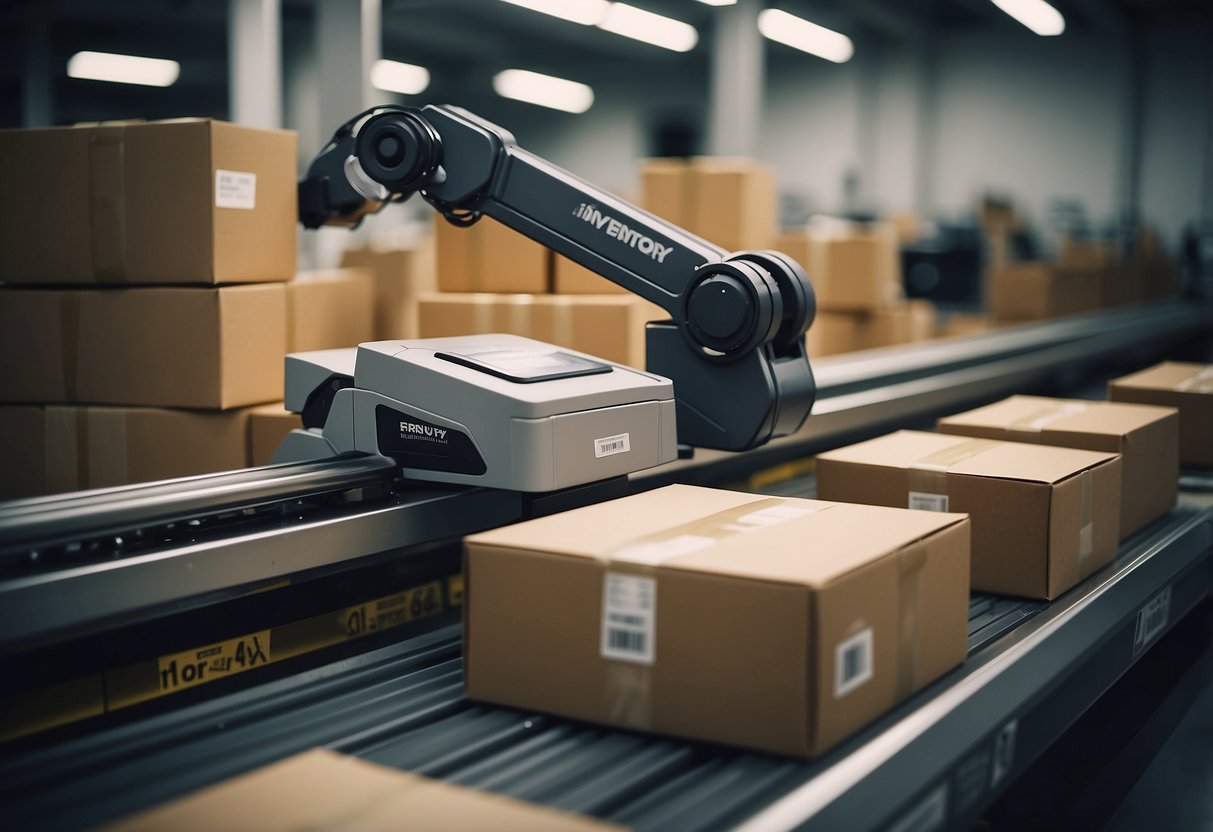Running an ecommerce business often feels like juggling multiple balls at once, doesn’t it? From managing inventory to providing stellar customer service, there’s always something demanding your attention.
Automating key areas of your ecommerce operations can free up your time and significantly improve efficiency.

Whether you’re a seasoned online retailer or just getting started, embracing automation can transform your daily workflow.
Imagine focusing more on strategy and growth, while software handles the mundane tasks. It’s not just a dream; with the right tools, it’s entirely possible!
1) Email Marketing Automation
Ever wish you could send the perfect email at just the right time? With email marketing automation, you can.
Imagine someone just abandoned their shopping cart. An automated email can remind them of their forgotten items, tempting them back to complete the purchase.
Do you have a huge sale coming up? Schedule personalized emails in advance.
Automation tools allow you to set up these campaigns, ensuring each customer gets a tailored message.
Birthdays and special events are goldmines for personalized emails. An automated birthday discount can make your customers feel special and lead to more sales.
Tracking and analytics are part of the package. You’ll get insights on open rates, click-through rates, and conversions. Use this data to refine your strategies further.
Ready to take your email game to the next level? Let automation handle the heavy lifting, while you watch your engagement soar.
2) Personalized Product Recommendations

Are you tired of scrolling endlessly to find what you need? Personalized product recommendations can change that for you.
By analyzing your past purchases, browsing behavior, and preferences, e-commerce platforms can suggest items tailored just for you.
Imagine logging in and seeing products you didn’t even know you wanted.
Studies show that personalized recommendations can boost sales by 10-30%. Retailers like Amazon use algorithms to predict and display items you’ll likely buy, making your shopping experience easier and more enjoyable.
You might have noticed that each time you visit the site, the recommendations get better.
This isn’t magic—it’s machine learning at work. The more data the system collects about your preferences, the smarter it gets. Over time, this means fewer unwanted suggestions and more finds that match your taste.
No more unnecessary browsing; let the platform do the heavy lifting. Personalized recommendations can save you time and expose you to new products you might love.
3) Chatbots for Customer Service

Ever gotten stuck waiting for customer service? Chatbots can be your solution!
These handy tools are available 24/7, ready to assist customers instantaneously. Whether it’s answering FAQs or processing returns, chatbots handle it efficiently, freeing up human staff for more complex issues.
You might wonder, how can chatbots be so effective?
Well, they use artificial intelligence to simulate human-like conversations. Programs like ChatGPT can even understand context and sentiment, making interactions smoother.
Brands like H&M have integrated chatbots to help with product recommendations and customer queries, enhancing the shopping experience.
Not only do chatbots improve customer experience, but they also save costs.
A study by Juniper Research found that chatbots could save businesses up to $8 billion annually by 2022. That’s a huge amount!
Plus, they can handle multiple customers at once, which traditional customer service can struggle with during peak times.
Still worried about the chatbot not being friendly?
Modern chatbots are designed to be engaging and polite. They can even be customized to reflect your brand’s tone and voice. Imagine having a virtual assistant that never gets tired and always greets your customers with a smile!
4) Abandoned Cart Reminders

Ever found yourself adding items to your cart, only to get distracted and forget to check out? You’re not alone. Studies show that 69% of online shopping carts are abandoned. That’s where abandoned cart reminders come in.
These reminders can be a game-changer for your eCommerce business.
Imagine sending an email or a text message to a customer who left items in their cart. It’s a gentle nudge that could convert a missed opportunity into a sale.
Timing is crucial.
The best results often come from sending the first reminder within one hour of the cart being abandoned. Follow-ups can be sent over the next few days, typically three reminders in total.
Personalization makes a huge difference.
Address customers by their name and include images of the items they left behind. It feels personal and not like a generic marketing message.
You can even offer an incentive.
A small discount or free shipping could be the final push the customer needs to complete their purchase. Just make sure your offer is enticing enough to motivate action.
Use these automated reminders wisely, and you’ll likely see an increase in recovered sales. It’s all about engaging your customers at the right moment with the right message.
5) Loyalty Program Management

Ever thought about how to keep your customers coming back for more? Loyalty program management is the key.
With automated loyalty programs, you can reward your repeat customers without lifting a finger. Some platforms even let you set up point-based systems, where customers earn points for each purchase. It’s like turning shopping into a game!
Automations can send personalized emails to remind customers about their points balance or offer exclusive discounts. This not only boosts engagement but also fosters a sense of community.
Imagine how easy it would be if you didn’t have to manually track loyalty points or send out rewards.
You can even set up tiered programs where customers unlock different rewards as they spend more. It’s all about making your customers feel special and appreciated.
Not to mention, automated loyalty programs can provide valuable insights into your customers’ buying habits. This helps you tailor your marketing strategies to better meet their needs.
Automating your loyalty program saves you time and ensures no customer feels neglected. It’s a win-win for both you and your customers!
6) Inventory Management Automation

Ever find yourself buried under a mountain of inventory spreadsheets? You’re not alone. Many eCommerce businesses struggle with keeping track of stock levels, restocking items, and avoiding overstock or stockouts.
By automating inventory management, you can save time and reduce errors.
An automated system will update your inventory in real time as sales occur, which keeps everything accurate and up-to-date.
Consider integrating your inventory system with your eCommerce platform. This way, your inventory levels will sync automatically across all your sales channels. No more manual updates!
You can also set up automated reorder points.
When stock levels hit a certain threshold, the system will alert you or even place an order with your supplier. Never run out of your best-selling items again!
Automation can also help with inventory forecasting.
Predict future demand based on past sales data, and adjust your stock levels accordingly. This ensures you always have the right amount of inventory.
Imagine having a system that can manage returns as well.
When a product is returned, the inventory automatically updates, making the process seamless. This can improve customer satisfaction and streamline your operations.
7) Order Tracking Notifications

Ever wondered where your order is after you’ve clicked “Buy Now”? Order tracking notifications keep you in the loop.
You know that feeling when you’re eagerly waiting for a package but have no clue where it is? Gone are the days of endless waiting. Automated order tracking notifications tell you exactly when your package will arrive.
You get updates at every shipping milestone. From dispatch to delivery, each step is covered. This not only reduces anxiety but also builds trust with your customers.
These notifications can be sent through multiple channels. SMS, email, and even push notifications can keep your customers informed. Why limit yourself to just one method? Use what’s best for your audience.
Automating this process saves time and effort. No more manually updating customers about their orders. Your team can focus on other important tasks, improving efficiency.
Ever experienced a lost package? Automated status updates can help prevent misunderstandings and keep everyone informed. A seamless tracking experience goes a long way in retaining customers.
8) Customer Feedback Collection

Have you ever wondered what your customers really think about your products? Collecting feedback is essential for understanding their needs and improving your offerings.
You can use simple tools like Google Forms or more specialized platforms like SurveyMonkey. Sending out periodic surveys via email can be an effective strategy.
Automate feedback requests after a purchase. Send a follow-up email asking for a quick review. It’s a great way to gather insights effortlessly.
Another option is using on-site surveys or pop-ups. They capture real-time customer opinions while shopping. Tools like Hotjar or Qualtrics can help you set these up easily.
Incorporate these feedback loops into your process, and you’ll be on your way to creating a better customer experience.
9) Social Media Posting Automation

Do you always feel like you’re racing against the clock to keep your social media alive and active? Social media posting automation is the key to saving time and maintaining consistent engagement with your audience.
With tools like Hootsuite, Buffer, or Later, you can schedule your posts in advance. Imagine setting up an entire week’s worth of posts in just a few hours! That’s more time for you to grow your business.
Automation ensures that your posts go live at the optimal times, even when you’re not around. Consistency is crucial for engagement, and these tools help you achieve it effortlessly.
Don’t worry about losing the human touch. You can still respond to comments and messages personally, while the routine tasks are handled automatically.
Integrate social media posting with your e-commerce platform. This way, new product launches or special promotions get posted without lifting a finger. Sounds dreamy, right?
10) Dynamic Pricing Adjustments

What if you could adjust your prices on the fly based on real-time demand and competition? Dynamic pricing does just that. It uses algorithms to change prices according to market conditions, such as competitor pricing, demand variations, and even time of day.
Think about airline tickets. Prices fluctuate based on the season, how close to departure, and seat availability. For eCommerce, this means you can increase prices when demand spikes or offer discounts to outcompete rivals during slow periods.
Dynamic pricing can boost your profits. Studies show that businesses using dynamic pricing see up to 25% more revenue. You can set rules like never going below cost or consider customer segments for personalized pricing. This way, your strategy is smart and profitable.
Don’t worry about managing it all manually. There are plenty of tools out there to help. Tools like Prisync or Omnia Retail offer features to automate this entire process. They monitor competitors, analyze market trends, and adjust your prices accordingly, saving you time and maximizing profits.
Implementing dynamic pricing might sound complex, but the benefits it brings make it worth the effort. Start simple, test small, and watch how it impacts your bottom line.
The Importance of E-commerce Automations

E-commerce automations are vital for enhancing the customer experience and boosting operational efficiency. Let’s explore how these automations can benefit your business.
Enhancing Customer Experience
Do you value happy customers? Automations can help you achieve that. For instance, personalized email campaigns can target customers based on their shopping behavior. Imagine a customer who left items in their cart; an automated reminder can bring them back to complete their purchase.
Real-time customer support is another game-changer. Implementing chatbots can assist customers 24/7. They can answer questions, provide product recommendations, or even process returns, all without human intervention. Quick, right?
Additionally, automations improve order tracking. Customers appreciate transparency, and automated systems can provide real-time updates on their order status. This leads to fewer inquiries and increased customer satisfaction.
Boosting Operational Efficiency
How about making your operations run like a well-oiled machine? Automations can help with that too.
Automations streamline many repetitive tasks. For example, inventory management systems can automatically reorder stock when levels are low, preventing stockouts or overstock situations.
Consider the time savings in order processing. Automated systems can handle order confirmations, shipping labels, and even invoicing without manual input. This reduces errors and speeds up the delivery process.
Marketing becomes more effective too. Automated tools can segment your audience and send targeted promotions, increasing the chances of converting leads into customers. Plus, they can analyze data to help you adjust strategies on the fly.
You’re not just saving time; you’re freeing up resources to focus on growth and innovation. Automations don’t just make your life easier; they make your business better.
Types of E-commerce Automations

E-commerce automations can transform your business processes, enhancing efficiency and customer satisfaction. By focusing on key areas like marketing and customer service, you can significantly streamline operations.
Marketing Automations
Marketing automations are essential for driving sales and engagement with minimal manual effort. One powerful tool is email marketing automation. You can send personalized emails to your subscribers based on their behavior, like abandoned cart emails or product recommendations.
Social media scheduling tools allow you to plan and automate posts across platforms. This keeps your brand active without needing daily attention.
Automated SMS campaigns can also reach customers instantly with offers and updates. Discount codes, special promotions, or seasonal greetings can easily be automated to keep your audience engaged.
Customer Service Automations
Customer service automations can make a big difference in how quickly and efficiently you can assist your customers.
Chatbots are a popular choice, providing instant responses to common inquiries. They can handle multiple queries simultaneously, reducing wait times.
Meanwhile, automated ticketing systems can organize and prioritize customer issues. This helps your support team focus on more complex problems, improving resolution times.
Self-service portals allow customers to find answers to their questions without needing to contact support.
FAQ sections, how-to guides, and video tutorials can be automatically updated and maintained, providing 24/7 assistance.
Both marketing and customer service automations allow you to scale your operations while maintaining a personal touch.




